Although it is true that I have been considered lunatic on many occasions in the last five hundred years, it must be stated, that the very beginning of this sad and extraordinary tale, that I have been most grievously misunderstood. The elixir of life was drunk in all innocence and my dog had nothing to do with it.
—The Discovery of Chocolate by James Runcie
Such begins The Discovery of Chocolate by James Runcie, a historical fiction piece that also includes a bit of sci-fi time travel, true undying love, and of course, chocolate.
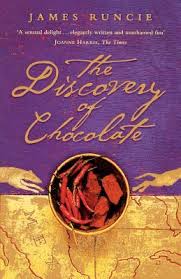
The Discovery of Chocolate is the February/March selection for Cook the Books. This round is hosted by Simona (bricriole) and you can read the announcement post here.
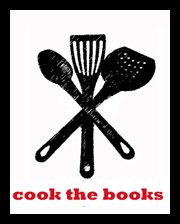
The author weaves his inventive tale around Diego de Godoy, a young Spaniard that finds himself attached as the notary to Cortés as he begins his exploration and plunder of the New World. Diego has embarked on this journey to impress a young Spanish woman who is waiting for him to return with something new and worthy of her beauty and love, some treasure from the New World.
Of course, Diego’s discovered treasure is chocolate but he also finds true love with Ignacia, a native woman. This meeting leads him on his five hundred year journey.
Runcie’s premise is clever and I started out loving the book. The author began losing me a bit after the “invention of Sachertorte.” Then there was the tragic and ludicrous invention of the Hershey Kiss.
Really? (Diego also invented Pain au chocolat.)
And the people he encounters along the way? Besides Cortés, he meets the following famous people (some a who’s who of the chocolate industry):
- Marquis de Sade
- Monsieur Debauve (of Debauve and Gallais, the French Royally Appointed Chocolatier)
- Franz Sacher, an Austrian confectionner
- Sigmund Freud
- Gustav Klimt
- Anton Bruckner (I think. I couldn’t pin point who the composer was that he and Claudia heard at the concert at St. Stephen’s.)
- Mr. Fry of J. S. Fry & Sons, Ltd. (a British chocolate company)
- Milton S. Hershey
- Gertrude Stein and Alice B. Toklas
I was anticipating that Pablo Escobar might make an appearance at the end of the book when he finds himself at a Mexican opium operation.
I loved the first part of the book, was mildly amused during his time in France, became annoyed with the insipid conversations in Vienna (in fact, the dialogue reminded me of a boring French film), didn’t really see the point of his time in England, and thought the Hershey Kiss wrap up was beyond absurd. Then Runcie throws in Stein and Toklas and I had to wonder if he was actually writing a farce.
“A mousse is a mousse is a mousse.”
Food abounds in the novel, and not just the sweets that one associates with chocolate. There’s the bounty of Mexican markets, fruit from Viennese orchards, and many savory dishes. (If you’re interested, there’s a very long list at the end of this post.)
I decided to experiment and make some bourbon infused cranberries and douse them in chocolate. I couldn’t help but be inspired by the Marquis de Sade’s raspberry liqueur creams as well as all the different liqueur combinations that Diego creates.
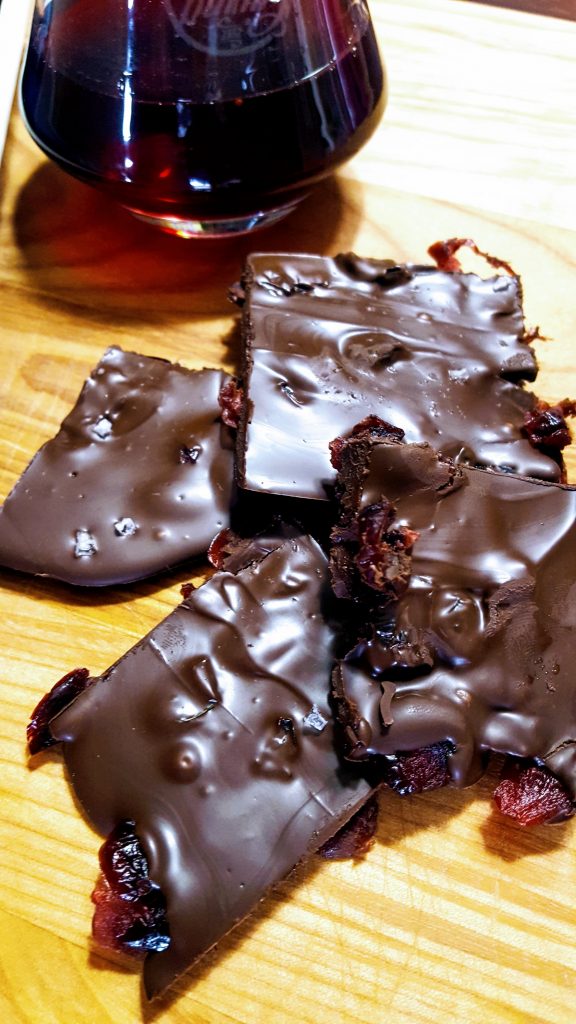
Bark with leftover cranberry-infused bourbon.
Bourbon-Cranberry Chocolate Bark
Inspired by the different liqueur combinations that Diego experimented with in France and Vienna, I created this bourbon infused confection.
Ingredients
- 5 oz. dried cranberries
- 1 c. bourbon (or your favorite booze)
- 1 (12 oz.) pkg. dark chocolate chips
- 2 T. shortening
- sprinkling of sea salt
Instructions
- Place cranberries in a small mixing bowl and cover with bourbon. Cover with plastic wrap and let set at room temperature overnight.
- Drain well (BUT SAVE THE BOURBON FOR A COCKTAIL). Place cranberries on a paper towel lined plate to continue to drain.
- While cranberries continue to dry, place chocolate chips and shortening in a double boiler, stirring frequently until melted.
- Line a cookie sheet with parchment paper and arrange cranberries in a single layer.
- Pour chocolate over cranberries. Sprinkle with coarse sea salt. Refrigerate until firm.
- Cut bark into pieces and enjoy!
Keep refrigerated.
I’m glad I did read the novel. It was entertaining. I am amazed at Runcie’s imaginative powers.
I was also glad that I used the leftover bourbon for a cocktail. I took the leftover mixture (a little over half a cup), divided it between two rocks glasses, added a bit of club soda and a splash of lemon. It tasted like an old fashioned with a lot of cherries. 🙂
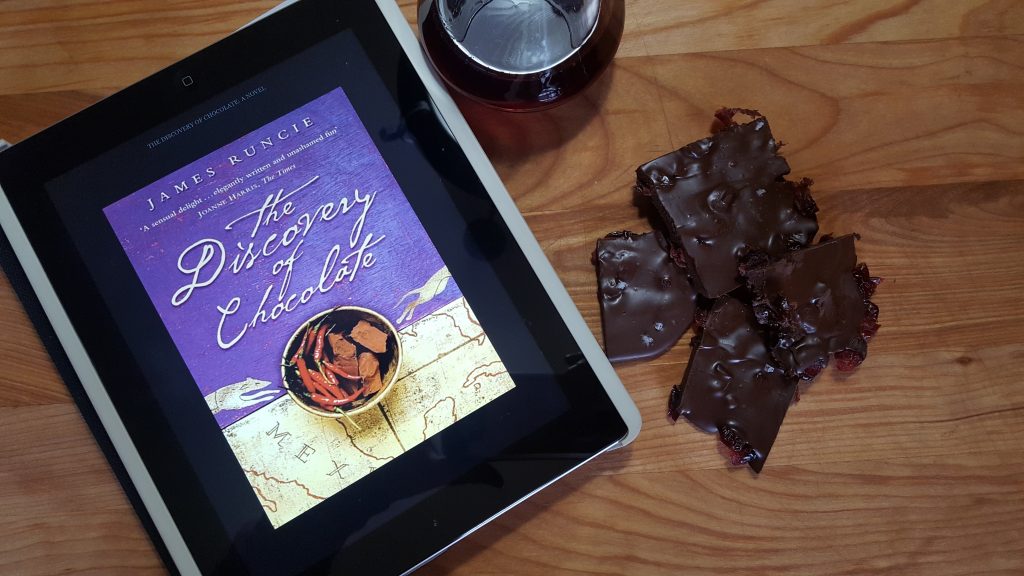
Here’s a long list of food references from The Discovery of Chocolate (with Kindle locations).
- “a great banquet of turkey and maize cakes, cherries, oranges, mangoes and pineapple” (165)
- “necklace of golden crabs” 258
- “small man-made islands where vegetables grow: peppers, tomatoes, avocado, papaya and granidilla.” (268)
- “turkeys, pheasants, wild boars, chickens, quails, ducks, pigeons, hares and rabbits.” 283
- “There were locusts with sage, and fish with peppers and tomatoes. There were frogs with green chilli, venison with red chilli, tamales filled with mushrooms, fruit, beans, eggs, snails, tadpoles and salamanders.” (283)
- “a deep brown liquid….the beverage had a cool and bittersweet taste, enlivened perhaps with chillies.” (300)
- orchard of fig trees (322)
- “Cacahuatl” (322)
- “stalls selling the richest of spices: salt and sage, cinnamon, aniseed and black pepper, mecasochitl, vanilla, ground hazelnut and nutmeg, achiote, chillies, jasmine and ambergris….roasting fowl, foxes, partridges, quails, turtle-doves, hares, rabbits and chickens as large as peacocks.” (331)
- “roasted meat in various sauces, tortillas and savoury tamales, maize cakes, dishes of fish or tripe and toasted gourd seeds sprinkled with salt or honey.” (340)
- a “finished mixture of cocao, sapota seed and maize…whisked into a foaming liquid” (350)
- An abundance of “figs, cherries, oranges and lemons” (480)
- Chocolate drink: chocolatl, nutmeg, cinnamon and black pepper, chillies, aniseed and honey (499)
- “I drank little but chocolatl; it was combined with honey, with flowers, with aniseed, with nutmeg and even with achiote, which made the mixture almost red in colour.” (510)
- “a turkey dish with chillies, vanilla, aniseed and chocolatl…she mixed almonds, raisins and sesame together…cinnamon from the bark of a tree, petals of star anise, with the fragrance of onion, chilli and cacao” (519-520)
- The transforming elixir: “full of peppers, chocolatl and chillies” (750)
- “tamales, tortillas and menudo; empanada de bacaloa, seviche de camrones, and pollo al pibil. ” (884)
- Mole poblano (884, 894)
- For the Spanish feast: watermelons, guinea fowl, partridge, quails and maize cakes; cherries, prickly pears, pineapples and mangoes.” (904)
- His invention of Pot de crème (1165)
- Doña Maria’s “death by chocolate”: chocolate, cardamom, cinnamon and chillies, a well-ground mixture of jimson weed, henbane and belladonna.” (1235)
- Marquis de Sade’s meals in the Bastille: “pâtés, hams and fruit preserves…almond paste, jellied quince and kumquats, cakes, spices” (1425)
- “violet chocolate cream, a chocolate mixed with the petals of roses.” (1451)
- Monsieur Debauve’s wares: “excellent breakfast chocolate…chocolate flavoured with salep for the fortification of muscle, an anti-spasmodic chocolate with orange blossom, and an almond-milk chocolate for the irritable.” (1466)
- The Marquis’ raspberry liqueur creams (1466-1534)
- The Marquis’ Bastille feast: “sorrel soup, artichoke terrine, and an almond and monkfish mousse, followed by partridges stuffed with Muscat grapes, red mullet sausages in chervil butter, medallions of foi gras, roast chicken with pine kernels, a gasconnade de pintades, cuttlefish cooked in pastis, marinated artichokes, stuffed courgette flowers in a tomato coulis, goat’s cheese truffles in olive pâté, Cressane pears, a nut galette, fresh grapes, four bottles of old burgundy, the best mocha coffee, and a large bottle of Armagnac.” (1569)
- At Debauve and Gallais (French Royally Appointed Chocolatier): “Persian salep and Japanese cachou,…pastille with almond milk to soothe the stomach, and a ganache with barley sugar cream for delicate ladies…scents of dark chocolate, orange flower water, ambergris and vanilla.” (1776)
- His invention of pain au chocolat (1776)
- The invention of the Sachertorte (1882-2105)
- Viennese temperament: “we are what we eat…perhaps it should not surprise us if we feel refreshed by grapefruit, lightened by a lemon soufflé, pleasured by wine, or reassured by chocolate.” (2120)
- His task by Herr Sacher to create chocolate liqueurs with “pickling jars and fermenting fruit: raspberries nestled in crème de cassis, cherries were drenched in cognac, and prunes improved immeasurable once they had been saturated in slivovitz. I believe that I was the first to use an early form of Grand Marnier.”(2128)
- Strawberry chocolate creams (2221)
- “Wild hare in a chocolate sauce with Chestnuts” and dumplings (2521)
- Hershey kisses
- Meal on the ship: “Chantilly soup, braised oxtail, or galantine of capon” (3234)
- The “very munctious” meal with Stein and Toklas: “miniature mushroom tartlets, herrings in oatmeal, and caviar blinis…Lovely hard-boiled eggs with whipped cream, truffles, and Madeira wine. Chicken Liver omeletes with six eggs and cognac…wood pigeon with chestnuts and cabbage…rabbit pie…lobster with beurre blanc” (3260-3289)
- “A mousse is a mousse is a mousse.” (3843)
- Ignacia’s “modern” chocolate (3593)
- Sugar skulls for Día de Muertos (3636)
- Diego’s return to a more modern market: “oranges, pineapples, limes and lemons; chickens, partirdges, quails and turkeys…piles of plantains, pumpkins and papayas…table of herbs selling not only cinnamon, aniseed and coriander, but also every kind of chili—ancho, mulato, pasilla, chipotle, guajillo and casabel” (3636)
- More plenty from the market: “Culourful breads—rosca de reyes and pan de muerto—lay waiting in richly stocked panaderias. Groups of men stood smoking and drinking lemonade, red sorrel flower tea, pulque from fermented sap, aqua miel, and freshly squeezed orange juice. There were enchiladas and enfrijoladas, steamed lamb tortillas filled with cheese, and tuna with roasted red pepper. I stopped by a stall selling thirty different kinds of mole poblano.” (3643)
- Diego’s purchase of “aniseed and avocado; chillies, cinnamon and chorizo; garlic, ginger, peppers, pumpkins, pulses and papaya; shrimps, scallops, limes, mangoes and maize.” (3666)
- His spread of delicacies for Ignacia: “vermicelli and gazpacho….seared cod with caramelised shallots, grilled calamari,…steamed shallots with ginger….marinated quails with rosemary, bay leaves and garlic…guacamole between paprika-toasted potato skins. Stuffed green peppers with a walnut sauce…pumpkin-blossom quesadillas….chorizo stew spiked with sherry and coriander….peaches, figs and strawberries…and mango cream with almonds.” (3843-3844)
Thanks for hosting this round, Simona.
Please check out our next four Cook the Books selections:
April/May: Shark’s Fin and Sichuan Peppery by Fuchsia Dunlop (hosted by Deb at Kahakai Kitchen)
October/November: The Cooking Gene by Michael Twitty (hosted by Simona at briciole)
You can read the announcement post here. Cook the Books membership is open to anyone. Just grab the book, read, become inspired, post a recipe….
I’m linking up with Novel Food (hosted by CTB co-host Simona)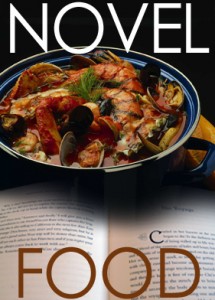
and
March’s Foodies Read.
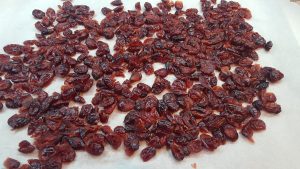
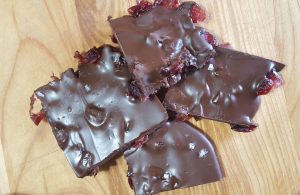



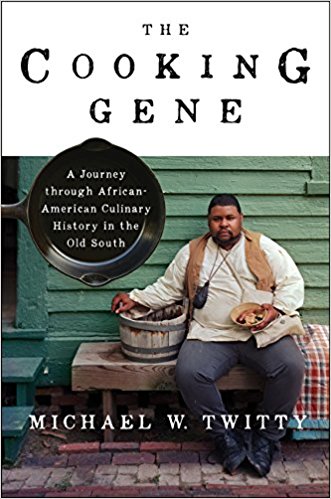

Maybe you should have quoted what Hemingway said when he was mad at Gertrude Stein: “a rose is a rose is an onion.” Not necessarily the book you hoped for! I’m still tempted to read it. I’ve read three of your upcoming selections and loved them, and plan to read “The Cooking Gene” sometime soon (Or did I already mention this to you?).
best… mae at maefood.blogspot.com
I hope you participate, Mae. Yes, I had forgotten about the Hemingway quote. I actually would recommend this book, it’s just that whole Hershey kiss thing. And, the presumption that the main character was credited with the invention of all the chocolate goodness.
The one bonus of reading this book is your yummy chocolate bark! Those bourbon cranberries sound amazing—so many uses for them!
Yes, just to get that cranberry-infused bourbon!
The whiskey soaked cranberries sound really amazing. Definitely grownup version of chocolate bark.
They paired perfectly with the dark chocolate.
I could eat bourbon infused cranberries by the handful. Covering them with chocolate just makes them more addicting.
I loved the byproduct!
I don’t generally like books with time travel but it seems harmless especially since he’s visiting all the chocolatiers of history.
I don’t about him falling in love with a Native woman to be romantic since the history behind Spaniards in the New World…
I recently made a sauce with dried cranberries (something I’ve never had before) and it was pretty sweet. I’m thinking the chocolate will balance it out if its dark enough?
There was lots of romance and I didn’t mind that—it was predictable the he would end up with Ignacia. That sauce sounds good. Adding chocolate would be interesting.
The book sounds like a fun idea, but it just went wrong. Nothing wrong with this wonderful looking chocolate bark, though! Perfect elixir of goodness. 🙂
I’m sure there are some who love the book. It just got a bit weird and way too predictable. I do have to say that Gertrude and Alice did throw me for a loop, though.
It was a very fanciful flight through the history of chocolate. Your bark sounds amazing and I’m sure the cherry infused bourbon was wonderful.
Way wonderful, Wendy!
The book was pretty uneven – once I got past the first 50 pages I almost gave up, but things improved a bit, amidst all the improbability. I like his later novels much better. Worth it for your fabulous bark though:)
I had the opposite experience. I enjoyed the first part of the book. It just seemed like the author was trying to through in every possible coincidence in the later part.
Are you familiar with the Italian “Bacio” by Perugina? It was created in my home town of Perugia and it also has a colorful (so to speak) story. I agree that the book was uneven and his later novels are better. It was inspirational, for sure. The infusion is a lovely idea. Thank you for contributing to Novel Food and Cook the Books 🙂
YES, I have seen that in stores. (Maybe World Market???) May have to make a trip there today to nab some. Thanks for hosting, Simona.
I too read Discovery of Chocolate– you can see my take on it in the round up. Am impressed with your listing of the chocolate timeline. I breezed in and out of the book, but settled on the use of chocolate in Mexican mole. Your treat looks lovely
Just stopped by. Your mole sounds amazing and may actually spur me to finally try my hand at it.
Well, the recipe came via Mexican cooking authority Rick Bayless, so by all means give the Mole a try
Love Rick Bayless (and he’s actually an Okie boy).
Now chocolate coated bourbon cranberries followed by a bourbon cocktail sounds like a great idea
Absolutely. I don’t know which was better??!!
I love listing out all the food possibilities, too! I’ve had a couple of books where it was hard to narrow down what recipe I wanted to connect with the novel. 😀
This recipe sounds perfect for holiday gift giving, as we usually fill a basket with homemade goodies for our neighbors.
It’s almost hard for me to make candy anytime other than the holidays! Thanks!
I am a fan of anything with bourbon! I wasn’t a huge fan of the book, but I love the dishes it inspired.
My thoughts exactly!
Your bark looks fantastic! I was not a fan of the book, but I’m loving the recipes!
I too read Discovery of Chocolate, and chose a savory chocolate dish – mole. Sweets made with chocolate are only an occasional dalliance for me but this looks great. I had to chuckle at your chronicle of the book’s many twists and turns. That’s quite an inventory!